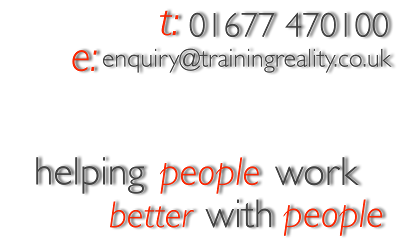Please press (at least!) one of these.
It costs you nothing, and (possibly) helps us spread the word!
Stress, teamwork, and the MBTI Inferior Function
Thursday, 30th June 2011
A lot of organisations, I'm glad to say, use Myers Briggs as a tool, in varying different ways. Unfortunately, they use it with varying success as well, and I think that the reason for this is related to one of the core foundations of the way we operate at trainingreality
When the application is less successful, it tends to be for a combination of two reasons:
- the profiles are skated over, as in "here is your type"; and
- the emphasis is on the model, not on the practical application of the model.
Our approach is rather different, and rather more effective. Instead of taking a broad-brush approach, we work with clients, in advance, to get an idea of which aspects of the model may be the most appropriate, and then, as a programme develops, we flex the content to meet the evolving understanding of the group.
One area that is becoming more and more frequent in its use at the moment is the oft-neglected "inferior function". The Jungian theory behind the inferior function is that this is (a) our least preferred mode of behaviour, (b) therefore our least practiced model of behaviour - we're potentially rubbish at it - and (c) that's the behaviour we demonstrate when we're under stress.
In simple terms, we become stressed when our normal/preferred modes of behaviour are not delivering the results we want, and so we "flip" to the opposite.
A couple of examples:
INTP
Someone with a preference profile of INTP has a dominant (most preferred) function of Introverted Thinking. The opposite of this is Extraverted Feeling so, under stress, the INTP, normally relatively quiet, calm and controlled, may erupt in a rare display of emotion - explosive anger or hurt tearfulness. They can often be a pressure-cooker, and the final straw that pushed them over the edge could be a very minor thing.
ESFJ
Someone with a preference profile of ESFJ has a dominant (most preferred) function of Extraverted Feeling. The opposite of this is Introverted Thinking so, under stress, the ESFJ, normally sociable, warm and sympathetic, can become very critical of themselves and others. They then worry, internally, about their negative thoughts.
So what?
Looking at behaviours under stress can be really helpful for both leaders and managers, and for members of a team with themselves and with others. By raising awareness of some of the more common stress behaviours, we can help them be noticed earlier, to be less shocking, and we can identify some simple, immediate actions to help the individual(s) concerned.
Let's say you have an INTP on your team, and (s)he is under stress. One day, perhaps triggered by a minor event, they explode with anger at someone, or perhaps burst out crying. This can, obviously, be rather unsettling for the team as a whole, as well as for the individual.
However, if the team has understood the stress reactions of different people, they will be less shocked - and hopefully not "join in" with the behaviour, and they will be able to respond with much greater understanding. They can also encourage the INTP to have some quiet time, away from other people, so get their thoughts together (getting them back into their preferred mode of operation.
It can, particularly in busy environments, be trickier with those team members with a preference for Extraversion. Unlike those with an Introversion preference, whose inferior function will be extraverted (i.e. really easy to spot!), they will tend to go quiet. This can often be missed for some time, and therefore increase the stress levels of the individual concerned.
If our ESFJ, normally so sociable, drifts into quietness, then this is as much a sign of stress as the explosive INTP. Being alert to this, and being ready with interpersonal support, can head off the potential isolation that this individual would feel.
--
The key to using Myers Briggs in the workplace, as with any model, is to steer clear of it being an interesting, academic exercise - there are other, more appropriate places for that to take place. It's about the trainer translating, and helping the group to translate whatever theory and model they are using into something that is directly relevant to them, and able to be used, in practice, back in the workplace.
Please press (at least!) one of these.
It costs you nothing, and (possibly) helps us spread the word!



